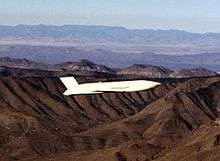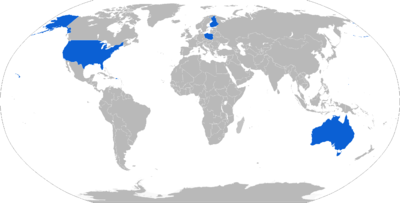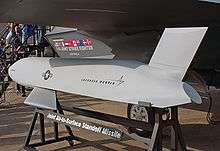AGM-158 JASSM
The AGM-158 JASSM (Joint Air-to-Surface Standoff Missile) is a low observable standoff air-launched cruise missile developed by Lockheed Martin for the United States Armed Forces.[4] It is a large, stealthy long-range weapon with a 1,000 pound (454 kg) armor piercing warhead. It completed testing and entered service with the U.S. Air Force in 2009, and has entered foreign service in Australia, Finland, and Poland as of 2014. An extended range version of the missile, the AGM-158B JASSM-ER (Joint Air-to-Surface Standoff Missile-Extended Range), entered service in 2014. By September 2016, Lockheed Martin had delivered 2,000 total JASSMs comprising both variants to the USAF.[5]
| AGM-158 Joint Air-to-Surface Standoff Missile | |
|---|---|
 | |
| Type | Air-launched cruise missile |
| Place of origin | United States |
| Service history | |
| In service | 2009–present |
| Used by | United States Air Force Royal Australian Air Force Finnish Air Force Polish Air Force |
| Wars | Syrian Civil War |
| Production history | |
| Designer | Lockheed Martin |
| Manufacturer | Lockheed Martin |
| Unit cost | US$1,266,000[1] (FY 2021) JASSM-ER: US$1.359M[2](FY15) |
| Produced | 1998–present |
| Specifications | |
| Mass | 1,021 kg (2,250 lb) |
| Length | 4.27 m (14 ft) |
| Warhead | 450 kg (1,000 lb) WDU-42/B penetrator |
| Engine | Teledyne CAE J402-CA-100 turbojet 3.0 kN (680 lb) |
| Wingspan | 2.4 m (7 ft 11 in) |
Operational range | JASSM: 370 km (230 mi) JASSM-ER: 925+ km (575+ mi) |
| Maximum speed | Subsonic |
Guidance system | Global Positioning System (GPS)-aided inertial navigation system (INS), terminal infrared homing automatic target recognition |
Launch platform | Integrated: B-1 Lancer B-2 Spirit B-52 Stratofortress F-15E Strike Eagle F-16 Fighting Falcon F/A-18 Hornet Potential: F-35[3] |
Program overview
Origins
The JASSM project began in 1995 after the cancellation of the AGM-137 TSSAM project. The TSSAM was designed as a high precision stealthy missile for use at stand-off ranges, but poor management of the project resulted in rising costs. Since the requirement for such weapons still existed, the military quickly announced a follow-up project with similar goals. Initial contracts for two competing designs were awarded to Lockheed Martin and McDonnell Douglas in 1996, and the missile designations AGM-158A and AGM-159A were allocated to the two weapons. Lockheed Martin's AGM-158A won and a contract for further development was awarded in 1998.
The AGM-158A is powered by a Teledyne CAE J402 turbojet. Before launch the wings are folded to reduce size. Upon launch the wings deploy automatically. There is a single vertical tail. Guidance is via inertial navigation with global positioning system updates. An imaging infrared seeker provides target recognition and terminal homing. A data link allows the missile to transmit its location and status during flight, allowing improved bomb damage assessment. The warhead is a WDU-42/B 450 kg (1000 lb) penetrator. The JASSM will be carried by a wide range of aircraft: the F-15E; F-16; F/A-18; F-35; B-1B; B-2; and B-52 are all intended to carry the weapon.[3]
The Center for Strategic and Budgetary Assessments (CSBA) has suggested lightening the warhead of the AGM-158A to increase its range. That way it would be able to be fired a greater distance from enemy air defenses while being cheaper and available in greater numbers for protracted conflicts than the AGM-158B JASSM-ER variant.[6]
Problematic development
In 1999, powered flight tests of the missile began. These were successful, and production of the JASSM began in December 2001. The weapon began operational testing and evaluation in 2002. Late that year, two missiles failed tests and the project was delayed for three months before completing development in April 2003. Two more launches failed, this time as a result of launcher and engine problems. In July 2007, a $68 million program to improve JASSM reliability and recertify the missile was approved by the Pentagon.[7] A decision on whether to continue with the program was deferred until Spring 2008.[8] Lockheed agreed to fix the missiles at its own cost and tightened up its manufacturing processes.[9]
On 27 August 2009, David Van Buren, assistant secretary of the Air Force for acquisition, said that there would be a production gap for the JASSM while further tests were held.[10] Further tests in 2009 were more successful however, with 15 out of 16 rounds hitting the intended target, well above the 75% benchmark set for the test. This cleared JASSM for entry into service.[11] The United States Air Force plans to acquire up to 4,900 AGM-158 missiles.[12] Meanwhile, the United States Navy had originally planned to acquire 453 AGM-158 missiles[13] but instead pulled out of the program in favor of the proven AGM-84 SLAM-ER.[12]
Foreign sales
In 2006 the Australian government announced the selection of the Lockheed Martin JASSM to equip the Royal Australian Air Force's F/A-18 Hornet fighters.[14] This announcement came as part of a program to phase out the RAAFs F-111 strike aircraft, replacing the AGM-142 Popeye stand off missile and providing a long-range strike capability to the Hornets. JASSM was selected over the SLAM-ER after the European Taurus KEPD 350 withdrew its tender offer, despite the KEPD 350 being highly rated in the earlier RFP process, due to their heavily involvement in the series preparation for the German Air Force, their troop trials in South Africa and their final negotiations with the Spanish Air Force which finally led to a contract.[15] As of mid-2010 the JASSM is in production for Australia and will soon enter service.[11]
Finland had also previously planned to purchase JASSM missiles for the Finnish Air Force as part of modernization plans of its F/A-18 Hornet fleet. However, in February 2007 the United States declined to sell the missiles, while agreeing to proceed as planned with other modernization efforts (the so-called Mid-Life Update 2, or MLU2). This episode led to speculation in the Finnish media on the state of Finnish – American diplomatic relations.[16] However, in October 2011 the US DSCA announced that they had given permission for a possible sale to Finland.[17] An order, valued 178.5 million Euros was placed in March 2012.[18] and since Lockheed has received three Finnish integration-related projects.[19] Finland's integration work was originally scheduled to be completed by the end of 2016, but didn't complete until March 2018 when Finnish F/A-18 Hornets successfully test fired two JASSM missiles at Naval Air Weapons Station (NAWS) China Lake.[20][21]
"JASSM is just as much a deterrent capability, as it is a strike capability. It makes the enemy pause and think twice about aggressive action, because it provides precision strike of a wide range of valuable targets."
— Senior Finnish official on why Finland needed these missiles, [22]
South Korea has sought the JASSM to boost the South Korean Air Force's striking capability but were rebuffed by Washington's unwillingness to sell the missile for strategic reasons. The South Korean government instead turned their attention towards the Taurus KEPD 350 missile.[23][24]
In 2014, Poland expected the Congressional approval for the purchase of the AGM-158 JASSM to extend the ground penetration capabilities of their top-of-the-line F-16 Block 52+ fighters. If the US Congress gives its approval, the missiles (around 200) should be deployed with the Polish Air Force in 2015.[25] Congress approved the sale in early October, and negotiations concluded in early November 2014. NATO member Poland signed a $250 million contract to upgrade its F-16s and equip the jets with (AGM-158) JASSM advanced cruise missiles in a ceremony at Poznan AB, Poland, on 11 December 2014.[26] The missiles are expected to enter operational service in 2017, and Poland is contemplating an additional purchase for the long-range JASSM-ER version.[27] In December 2015 the production contract for Lot 13 was signed. The contract includes 140 JASSMs for Finland, Poland and the US, 140 JASSM-ER missiles for the US, and data, tooling and test equipment. It is said to be the last production lot that will include non-ER versions. Poland's first modified F-16s should be ready by 2017, when the first missiles are delivered. The work is scheduled to be complete by June 29, 2019.[28] In November 2016 The U.S. State Department approved the possible sale of 70 AGM-158B JASSM-ER to Poland.[29]
Improved JASSM versions
AGM-158B JASSM-ER
The US Air Force studied various improvements to the AGM-158, resulting in the development of the JASSM-Extended Range (JASSM-ER), which received the designation AGM-158B in 2002. Using a more efficient engine and larger fuel volume in an airframe with the same external dimensions as the JASSM, the JASSM-ER is intended to have a range of over 575 miles (925 km) as compared to the JASSM's range of about 230 miles (370 km). Other possible improvements were studied but ultimately not pursued, including a submunition dispenser warhead, new types of homing head, and a new engine giving ranges in excess of 620 miles (1,000 km). The JASSM-ER has 70% hardware commonality and 95% software commonality with the original AGM-158 JASSM.[30]
The first flight test of the JASSM-ER occurred on May 18, 2006 when a missile was launched from a U.S. Air Force B-1 bomber at the White Sands Missile Range in New Mexico. The initial platform for the JASSM-ER is the B-1.[31] While both the original JASSM and the JASSM-ER are several inches too long to be carried in the internal weapons bay of the F-35 Lightning II, the F-35 will be able to carry both missiles externally, which compromises the aircraft's stealth features.[32]
The JASSM-ER entered service with the USAF in April 2014. Although the B-1 was initially the only aircraft able to deploy it, it was later integrated onto the B-52, F-15E, and F-16;[33] the B-1B can carry a full load of 24 JASSM-ERs, the B-2 16 missiles,[34][35] and the B-52 outfitted with the 1760 Internal Weapons Bay Upgrade (IWBU) is able to carry 20 JASSM-ERs, eight internally and 12 on external pylons.[36][37][38] The Air Force approved full-rate production of the JASSM-ER in December 2014.[39] Integration of the JASSM-ER onto the B-52 and F-16 was expected to wrap up in 2018, with the F-15E completed after that;[40] it was announced that the JASSM-ER achieved full operational capability on the F-15E in February 2018.[41] Lot 15 production contract, awarded in June 2017 was the first consisting entirely JASSM-ER.[42]
On 14 May 2015, the head of the Air Force Research Laboratory nominated the JASSM-ER as the optimal air vehicle to carry the Counter-electronics High Power Microwave Advanced Missile Project (CHAMP) payload. CHAMP is an electronic warfare technology that fries electronic equipment with bursts of high-power microwave energy, non-kinetically destroying them. The JASSM-ER was chosen because it is an operational system, so CHAMP is to be miniaturized into the operationally relevant system.[43]
In November 2019, the Air Force retired the AGM-86C/D air-launched cruise missile (ALCM), a conventional warhead-equipped version of the nuclear-tipped ALCM, with its role replaced by the JASSM-ER.[44][45]
AGM-158C LRASM
The JASSM-ER is also the basis for Long Range Anti-Ship Missile, which is a JASSM-ER with a new seeker.[46] The Air Force used the B-1 Lancer to complete a captive carry test of an LRASM to ensure the bomber can carry it, as both missiles use the same airframe. The LRASM was not originally planned to be deployed on the B-1, being intended solely as a technology demonstrator,[47] but in February 2014 the Pentagon authorized the LRASM to be integrated onto air platforms, including the Air Force B-1, as an operational weapon to address the needs of the Navy and Air Force to have a modern anti-ship missile.[48] In August 2015, the Navy officially designated the air-launched LRASM as "AGM-158C".[49] The LRASM achieved Early Operational Capability on the B-1B in December 2018.[50]
AGM-158D JASSM-XR
In March 2016, Lockheed Martin began analysis on an enhanced wing design to further increase range.[51] In September 2018, the corporation was awarded a contract to develop an "Extreme Range" variant of the AGM-158. The weapon would weigh about 5,000 lb (2,300 kg) and deliver a 2,000 lb (910 kg) warhead out to a range of 1,000 nmi (1,900 km; 1,200 mi).[52][53] The AGM-158D upgrade, previously called JASSM-XR, includes a missile control unit, changes to the wings, a different paint coating, an Electronic Safe and Arm Fuze, secure GPS receiver, and program protection requirements at a unit cost of $1.5 million. Low-rate initial production is to begin in 2021 as part of Lot 19 with deliveries beginning in January 2024 at a rate of five per month for the first 40 missiles.[54]
Operational history
The JASSM was first employed during the 14 April 2018 missile strikes against Syria during the Syrian Civil War. Two B-1 Lancers fired a total of 19 JASSMs as part of strikes against three Syrian government alleged chemical weapons targets.[55][56][57] All 19 JASSM missiles were fired at the Barzah Research Center, which was destroyed in the strike.[58] According to Russian state media, two missiles that failed to detonate were found by the Syrian Arab Army and transferred to Russia on 18 April for study - no evidence of this claim has been provided;[59] initial reports had stated JASSM-ER missiles were used, but it was later clarified that baseline JASSM models were employed.[60]
On 27 October 2019, at the end of the Barisha raid to capture or kill Abu Bakr al-Baghdadi, the then-leader of the Islamic State of Iraq and the Levant (ISIL) terror organization, a number of AGM-158B missiles were used to completely level the compound where the raid took place, marking the second time the missile has been used in combat.[61]
Operators


Specifications
AGM-158A JASSM
- Length: 4.27 m (14 ft)
- Wingspan: 2.4 m (7 ft 11 in)
- Weight: 975 kg (2,150 lb)
- Speed: Subsonic
- Range: 370 km (230 mi)
- Propulsion: Teledyne CAE J402-CA-100 turbojet; thrust 3.0 kN (680 lbf)
- Fuel: JP10 fuel
- Warhead: 450 kg (1000 lb) WDU-42/B penetrator
- Production unit cost: $850K
- Production dates: 1998–present
AGM-158B JASSM (ER)
- Speed: Subsonic
- Range: 925+ km (575+ mi)
- Production unit cost: $1.327 million
- Propulsion: Williams International F107-WR-105 turbofan
- Production dates: 2006–present
See also
- AGM-137 TSSAM
- Storm Shadow/SCALP EG
- KEPD 350 (Taurus missile)
- Hatf-VIII (Ra'ad)
- SOM (missile)
- Wan Chien
- List of missiles
References
- https://www.thedrive.com/the-war-zone/32277/here-is-what-each-of-the-pentagons-air-launched-missiles-and-bombs-actually-cost. Retrieved 15 Feb 2020. Missing or empty
|title=(help) - "GAO-15-342SP DEFENSE ACQUISITIONS Assessments of Selected Weapon Programs" (PDF). US Government Accountability Office. March 2015. p. 95. Archived (PDF) from the original on 24 September 2015. Retrieved 15 July 2015. Program unit cost
- "JASSM". Lockheed Martin. Archived from the original on 9 May 2015. Retrieved 27 May 2015.
B-1, B-2, B-52, F-16, F-15E and F/A-18 integrated
- "AGM-158 JASSM Air-Launched Cruise Missile | Military-Today.com".
- US Air Force Takes Delivery of 2,000th JASSM Cruise Missile Archived 2016-09-20 at the Wayback Machine – Deagel.com, 6 September 2016
- Study: Pentagon Missing Target on Air Weapon Investments – Nationaldefensemagazine.org, 23 June 2015
- "$68M plan to fix JASSM gets the OK". Air Force Times.
- "Pentagon To Announce JASSM Decision In 2008 – Amy Butler/Aerospace Daily & Defense Report". Archived from the original on September 27, 2007.
- "Lockheed $6 Billion Missile Program May Be Killed, U.S. Says". Bloomberg. Retrieved 8 October 2015.
- "JASSM Production Gap Manageable USAF Says". Aviation Week. Retrieved 8 October 2015.
- Pittaway, Nigel (March 2010). "JASSM introduction to RAAF service". Defence Today. Amberley: Strike Publications. 8 (2): 11. ISSN 1447-0446.
- "JASSM/ No Ma'am – Which Will It Be?". Archive.org. Defence Industry Daily. 12 Oct 2005. Archived from the original on April 6, 2007. Retrieved 3 June 2015.
- Rivers, Brendan (1 Feb 2006). "JASSM Program Getting Back on Track". Archive.org. eDefence. Archived from the original on March 16, 2006. Retrieved 3 June 2015.
- Defense Industry Daily (28 May 2014). "Australia Chooses JASSM Missiles on F-18s for Long-Range Strike". Archived from the original on 4 March 2016. Retrieved 26 December 2015.
- "ADM: ADF Weapons: Was JASSM the right choice?". Archived from the original on 23 September 2015. Retrieved 8 October 2015.
- "USA Refuses to Sell Finland Missiles for Hornet Fighters". Yle Uutiset. Archived from the original on 8 December 2015. Retrieved 8 October 2015.
- "Finland – AGM-158 Joint Air-to-Surface Standoff Missiles (JASSM)" (PDF). Defense Security Cooperation Agency. Archived (PDF) from the original on 4 March 2016. Retrieved 26 December 2015.
- "Suomen Puolustusministeriö – Suomi hankkii pitkän kantaman ilmasta-maahan ohjusjärjestelmän". Retrieved 8 October 2015.
- Hemmerdinger, Jon (10 January 2014). "Lockheed moves forward with Finland's JASSM integration". Flightglobal.com. Archived from the original on 26 May 2015. Retrieved 26 May 2015.
- "Hornet-kalusto saavuttaa suorituskykynsä huipun". Finnish Defense Forces. 10 Apr 2015. Archived from the original on 2015-09-04. Retrieved 4 Dec 2015.
- "Long-Term Development Key to Sustained Air Defense Capability". The Finnish Defence Forces. June 25, 2019.
- Sabak, Juliusz (6 Nov 2014). "JASSM for Poland – Is it worth to pay the price?". Defence24.com. Archived from the original on 19 April 2015. Retrieved 26 May 2015.
- "S.Korea to buy bunker busting missiles from Europe". www.reuters.com. 4 April 2013. Archived from the original on 4 July 2013. Retrieved 16 November 2013.
- "Parliament advises review of Taurus, Global Hawk acquisition plan". www.koreaherald.com. 5 July 2013. Archived from the original on 3 November 2013. Retrieved 16 November 2013.
- "The Aviationist » Why is Poland purchasing Joint Air-to-Surface Standoff Missiles for its F-16s?". The Aviationist. Archived from the original on 3 October 2015. Retrieved 8 October 2015.
- Air Force Magazine, Daily Report, December 15, 2014
- Poland concludes JASSM purchase for F-16 fleet Archived 2014-11-05 at the Wayback Machine – Flightglobal.com, 5 November 2014
- "Lockheed Martin wins $302m JASSM contract". Airforce-technology.com. 4 Dec 2015. Archived from the original on 7 December 2015. Retrieved 4 Dec 2015.
- "Poland – JASSM-ER with Support - The Official Home of the Defense Security Cooperation Agency". Dsca.mil. Archived from the original on 4 February 2019. Retrieved 3 February 2019.
- "GAO-13-294SP DEFENSE ACQUISITIONS Assessments of Selected Weapon Programs" (PDF). US Government Accountability Office. March 2013. pp. 81–2. Archived (PDF) from the original on 14 April 2013. Retrieved 26 May 2013.
- Pappalardo, Joe. "B-1 Pilots Turn Their Bombsights to the Pacific." Archived 2012-04-11 at the Wayback Machine Popular Mechanics. April 9, 2012.
- "Croft, John. "USAF sets 2013 entry for extended-range JASSM." Flight International. 06 Apr 2010. Accessed 9 Dec 2010". Archived from the original on 11 June 2010. Retrieved 9 December 2010.
- US Air Force Takes Delivery of First Production Lot of the JASSM ER Cruise Missile Archived 2014-04-10 at the Wayback Machine – Deagel.com, 8 April 2014
- B-1 carries first full JASSM load Archived March 5, 2016, at the Wayback Machine - AF.mil, 8 September 2010
- JASSM-ER nears operational employment Archived 2016-03-24 at the Wayback Machine – AF.mil, 9 August 2012
- Barksdale unit first to train with latest B-52 upgrade Archived 2016-08-18 at the Wayback Machine – AF.mil, 24 May 2016
- LRSO: The Nuclear Cruise Missile Mission Archived 2016-07-12 at the Wayback Machine – Fas.org, 20 October 2015
- We Already Have an Arsenal Plane: It’s Called the B-52 Archived 2016-06-23 at the Wayback Machine – Warontherocks.com, 22 June 2016
- US Air Force Approves Full Rate Production for JASSM-ER Cruise Missile Archived 2014-12-16 at the Wayback Machine – Deagel.com, 15 December 2014
- Vintage Boeing B-52 gets new long-range Lockheed cruise missile Archived 2015-11-25 at the Wayback Machine – Flightglobal.com, 23 November 2015
- Lockheed Martin's JASSM®-ER Declared Operational on F-15E Strike Eagle Archived 2018-02-12 at the Wayback Machine – PRNewswire.com, 6 February 2018
- Karas, Rachel (2017-06-02). "Air Force, Lockheed ink deal for first entirely JASSM-ER lot". Inside Defense. Archived from the original on 2018-02-12. Retrieved 2017-06-06.
- "USAF nominates JASSM missile to host new computer-killing weapon" Archived 2015-05-19 at the Wayback Machine – Flightglobal.com, 14 May 2015
- Everstine, Brian W. "Conventional Air-Launched Cruise Missile Ends Service". Air Force Magazine, 26 November 2019.
- Rogoway, Tyler. "The AGM-86C Cruise Missile That Introduced GPS Guided Weaponry Is Bowing Out Of Service". The Drive, 24 November 2019.
- "Mujumdar, Dave. "Lockheed LRASM completes captive carry tests." Flight Global, 11 July 2013. Accessed 12 July 2013". Archived from the original on 16 July 2013. Retrieved 12 July 2013.
- B-1 test squadron demonstrates anti-ship missile Archived September 10, 2014, at the Wayback Machine - Af.mil, 15 July 2013
- Majumdar, Dave (13 March 2014). "Navy to Hold Contest for New Anti-Surface Missile". U.S. Naval Institute. Archived from the original on 13 March 2014. Retrieved 13 March 2014.
- Lockheed Martin's LRASM Anti-Ship Missile Just Got its U.S. Navy Designation: AGM-158C Archived 2015-08-31 at the Wayback Machine – Navyrecognition.com, 24 August 2015
- Lockheed Martin delivers first Long Range Anti-Ship Missiles Archived 2018-12-21 at the Wayback Machine. Flight International. 20 December 2018.
- "U.S. Air Force Awards Lockheed Martin $37 Million For New JASSM-ER Wing Design" Archived 2017-07-21 at the Wayback Machine – PRNewswire.com, 19 July 2017.
- "US Air Force Moving Forward with Lockheed's JASSM-XR missile development" Archived 2018-09-13 at the Wayback Machine. Air Recognition. 11 September 2018.
- "America's Next Cruise Missile Will Strike From 1,000 Miles Away" Archived 2018-09-14 at the Wayback Machine. Popular Mechanics. 12 September 2018.
- USAF to Start Buying ‘Extreme Range’ JASSMs in 2021. Air Force Magazine. 14 January 2020.
- Trevithick, Tyler Rogoway and Joseph. "United States, France, And UK Begin Air Strikes On Syria (Updating Live)". The Drive. Archived from the original on 24 February 2019. Retrieved 3 February 2019.
- Navy Vessels, B-1s Obliterate 3 Syrian Targets in Strike Archived 2018-04-14 at the Wayback Machine. Military.com. 14 April 2018.
- Copp, Aaron Mehta, Tara (17 April 2018). "Coalition launched 105 weapons against Syria, with none intercepted, DoD says". Military Times. Archived from the original on 15 December 2018. Retrieved 3 February 2019.
- "US-led strikes on Syria: What was hit?". Bbc.com. 16 April 2018. Archived from the original on 15 April 2018. Retrieved 3 February 2019.
- "Эксперт рассказал, как Россия использует найденные в Сирии ракеты США". RIA Novosti. 19 April 2018. Archived from the original on 19 April 2018. Retrieved 19 April 2018.
- Pawlyk, Oriana (17 April 2018). "US May Ramp Up Buy of the Missile That Just Made Combat Debut in Syria". Military.com. Archived from the original on 11 October 2018. Retrieved 3 February 2019.
- http://www.airforcemag.com/Features/Pages/2019/October%202019/JASSMs-Used-to-Level-Baghdadis-Compound-in-Syria.aspx
External links
| Wikimedia Commons has media related to AGM-158 JASSM. |
